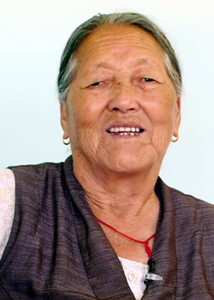Name: Kalsang Lhamo
(Alias: No)
Gender: Female
Interview Age: 82
Date of Birth: 1935
Birthplace: Dhiwu, Kham, Tibet
Year Left Tibet: 1958
Profession: Farming
Monk/Nun: No
Political Prisoner: No

Interview No.: 34U
Date: 2017-04-03
Language: Tibetan
Location: Dekyiling Tibetan Settlement, Sahastradhara, Uttarakhand, India
Categories: Culture and History
Keywords: customs/traditions, death/burial customs, farm life, food/drink, Kham, marriage practices, refugee in India -- life as
Summary:
Kalsang Lhamo was born in 1935 in Dhiwu, Kham Province. In that region crops were harvested once or twice each year, depending on where they were grown. Handmade tools and animals were used in the cultivation process and the families took turns helping each other. Kalsang Lhamo describes the types of barley and products made from it. Water was channeled from the mountains and distributed into the fields by canals. Her family owned three huge copper pots for storing water to use in the house, but they had to carry the water to the pots on their backs.
Kalsang Lhamo recalls the local death rituals - the rich were cremated and the poor were disposed of in the river. In her region there were no schools, but boys could receive an education at the monasteries. There was even a shortage of men because so many became monks. Despite the shortage, it was common for a family to bring home one bride for two or more sons. This resulted in an abundance of unwed women, but there was no stigma for these women to have illegitimate children.
Kalsang Lhamo ran away from home to Lhasa as young woman, working as a laborer along the way to earn food. Because she came from a small village, she was not prepared to survive in a big city and she decided to live with a man so he could take care of her. He brought her to India, where she eventually reunited with her family. Kalsang Lhamo later made two visits back to her hometown in Tibet.
Interview Team:
- Marcella Adamski (Interviewer)
- Tenzin Yangchen (Interpreter)
- Tenzin Choenyi (Videographer)

